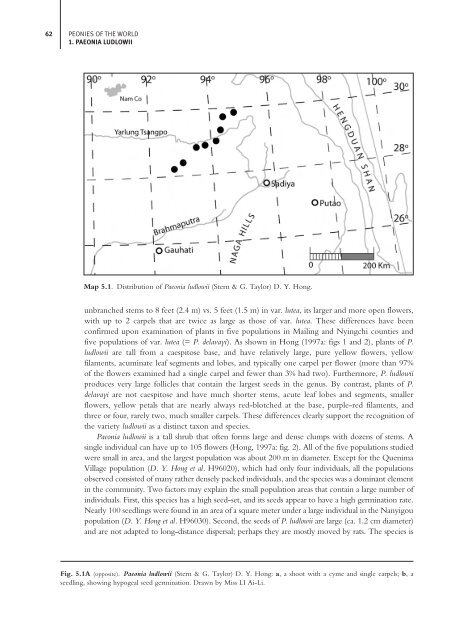Peonies of the World - Look inside - Royal Botanic Gardens, Kew
Peonies of the World - Look inside - Royal Botanic Gardens, Kew
Peonies of the World - Look inside - Royal Botanic Gardens, Kew
You also want an ePaper? Increase the reach of your titles
YUMPU automatically turns print PDFs into web optimized ePapers that Google loves.
62 PEONIES OF THE WORLD<br />
1. PAEONIA LUDLOWII<br />
Map 5.1. Distribution <strong>of</strong> Paeonia ludlowii (Stern & G. Taylor) D. Y. Hong.<br />
unbranched stems to 8 feet (2.4 m) vs. 5 feet (1.5 m) in var. lutea, its larger and more open flowers,<br />
with up to 2 carpels that are twice as large as those <strong>of</strong> var. lutea. These differences have been<br />
confirmed upon examination <strong>of</strong> plants in five populations in Mailing and Nyingchi counties and<br />
five populations <strong>of</strong> var. lutea (= P. delavayi). As shown in Hong (1997a: figs 1 and 2), plants <strong>of</strong> P.<br />
ludlowii are tall from a caespitose base, and have relatively large, pure yellow flowers, yellow<br />
filaments, acuminate leaf segments and lobes, and typically one carpel per flower (more than 97%<br />
<strong>of</strong> <strong>the</strong> flowers examined had a single carpel and fewer than 3% had two). Fur<strong>the</strong>rmore, P. ludlowii<br />
produces very large follicles that contain <strong>the</strong> largest seeds in <strong>the</strong> genus. By contrast, plants <strong>of</strong> P.<br />
delavayi are not caespitose and have much shorter stems, acute leaf lobes and segments, smaller<br />
flowers, yellow petals that are nearly always red-blotched at <strong>the</strong> base, purple-red filaments, and<br />
three or four, rarely two, much smaller carpels. These differences clearly support <strong>the</strong> recognition <strong>of</strong><br />
<strong>the</strong> variety ludlowii as a distinct taxon and species.<br />
Paeonia ludlowii is a tall shrub that <strong>of</strong>ten forms large and dense clumps with dozens <strong>of</strong> stems. A<br />
single individual can have up to 105 flowers (Hong, 1997a: fig. 2). All <strong>of</strong> <strong>the</strong> five populations studied<br />
were small in area, and <strong>the</strong> largest population was about 200 m in diameter. Except for <strong>the</strong> Quenima<br />
Village population (D. Y. Hong et al. H96020), which had only four individuals, all <strong>the</strong> populations<br />
observed consisted <strong>of</strong> many ra<strong>the</strong>r densely packed individuals, and <strong>the</strong> species was a dominant element<br />
in <strong>the</strong> community. Two factors may explain <strong>the</strong> small population areas that contain a large number <strong>of</strong><br />
individuals. First, this species has a high seed-set, and its seeds appear to have a high germination rate.<br />
Nearly 100 seedlings were found in an area <strong>of</strong> a square meter under a large individual in <strong>the</strong> Nanyigou<br />
population (D. Y. Hong et al. H96030). Second, <strong>the</strong> seeds <strong>of</strong> P. ludlowii are large (ca. 1.2 cm diameter)<br />
and are not adapted to long-distance dispersal; perhaps <strong>the</strong>y are mostly moved by rats. The species is<br />
Fig. 5.1A (opposite). Paeonia ludlowii (Stern & G. Taylor) D. Y. Hong: a, a shoot with a cyme and single carpels; b, a<br />
seedling, showing hypogeal seed germination. Drawn by Miss LI Ai-Li.

















